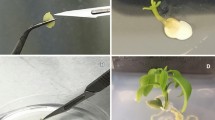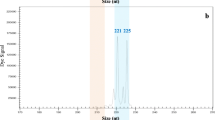Abstract
Seedlessness is one of the most important characteristics for mandarins for the fresh-fruit market and mandarin triploid hybrids have this trait. Citrus triploid plants can be recovered by 2x × 2x sexual hybridisations as a consequence of the formation of unreduced gametes at low frequency. Triploid embryos are found in small seeds that do not germinate under greenhouse conditions. Extensive breeding programs based on this type of hybridisation require very effective methodologies for embryo rescue and ploidy evaluation. In this work, we describe an effective methodology to recover triploid hybrids from 2x × 2x hybridisations based on in vitro embryo rescue and ploidy level determination by means of flow cytometry. The influence of parents and environmental conditions on obtaining triploid hybrids has been analysed. The strongest effect was associated with the genotype of the female parent while a strong interaction was found between the male parent genotype and environmental conditions. The effect of the female parent genotype on the length of the juvenile phase was also demonstrated by observing a large number of progenies over the last 10 years. The methodology described here has enabled us to obtain over 4,000 triploid hybrids so far, of which 13 have been protected in the European Union and two are being extensively planted by citrus growers to establish new commercial plots. These triploid hybrids have been analysed with simple sequence repeats markers to differentiate all the new triploid varieties and their parents, and thus molecular identification will help defend plant breeders’ rights.







Similar content being viewed by others
References
Aleza P, Juárez J, Ollitrault P, Navarro L (2009) Production of tetraploid plants of non apomictic citrus genotypes. Plant Cell Rep. doi:10.1007/s00299-009-0783-2
Aleza P, Cuenca J, Juárez J, Pina JA, Navarro L (2010) ‘Garbí’ mandarin: a new late-maturing triploid hybrid. HortScience 45(1):139–141
Bono R, Soler J, Buj A, Villalba D, Salvia J, Bellver R, Mares M, Méndez JV, Gavilá L (2006) El problema de la presencia de semillas en los frutos cítricos. Conselleria de Agricultura Pesca y Alimentación, Ficha Técnica serie citricultura No. 5
Cameron JW, Burnett RH (1978) Use of sexual tetraploid seed parents for production of triploid citrus hybrids. HortScience 13:167–169
Cameron JW, Frost HB (1968) Genetic, breeding and nucellar embryony. In: Reuther W, Batchelor LD, Webber HJ (eds) The citrus industry, vol 1. University of California, Riverside, pp 325–370
Chen C, Lyon MT, O’Malley D, Federici CT, Gmitter J, Grosser JW, Chaparro JX, Roose ML, Gmitter FG (2008) Origin and frequency of 2n gametes in Citrus sinensis × Poncirus trifoliata and their reciprocal crosses. Plant Sci 174:1–8
Cuenca J, Aleza P, Juárez J, Pina JA, Navarro L (2010) ‘Safor’ mandarin: a new citrus mid-late triploid hybrid. HortScience 45(6) (in press)
Dellaporta J, Hicks JB (1983) A plant DNA minipreparation: version II. Plant Mol Biol Rep 1:19–21
Dermen H (1938) Detection of polyploidy by grain size: investigation with peaches and apricots. Proc Am Soc Hortic Sci 35:96–103
Elgersma A, Stephenson AG, Nijs APM (1989) Effects of genotype and temperature on pollen tube growth in perennial ryegrass (Lolium perenne L.). Sex Plant Reprod 2:225–230
Esen A, Soost RK (1971a) Unexpected triploids in citrus: their origin, identification and possible use. J Hered 62:329–333
Esen A, Soost RK (1971b) Tetraploid progenies from 2x–4x crosses of citrus and their origin. J Am Soc Hortic Sci 97:410–414
Esen A, Soost RK (1973) Precocious development and germination of spontaneous triploid seeds in citrus. J Hered 64:147–154
Esen A, Soost RK, Geraci G (1978) Seed set, size and development after 4x–2x and 4x–4x crosses in citrus. Euphytica 27:283–293
FAO, Food and Agriculture Organization (2009) http://faostat.fao.org/site/567/default.aspx#ancor
Fatta Del Bosco S, Matranga G, Geraci G (1992) Micro and macro-sporogenesis of two triploid hybrids of citrus. In: Proceedings of 7th international citrus congress, vol 1, International Society of Citriculture, Acireale, Italy, pp 122–124
Froelicher Y, Dambier D, Bassene JB, Costantino G, Lotfy S, Didout C, Beaumont V, Brottier P, Risterucci AM, Luro F, Ollitrault P (2008) Characterization of microsatellite markers in mandarin orange (Citrus reticulata Blanco). Mol Ecol Resour 8(1):119–122
Geraci G, Esen A, Soost RK (1975) Triploid progenies from 2x–2x crosses of citrus cultivars. J Hered 66:177–178
Jefferies CJ, Brain P, Stott KG, Belcher AR (1982) Experimental systems and mathematical model for studying temperature effects on pollen-tube growth and fertilization in plum. Plant Cell Environ 5:231–236
Jóhannsson MH, Stephenson AG (1998) Effects of temperature during microsporogenesis on pollen performance in Cucurbita pepo L. (Cucurbitaceae). Int J Plant Sci 159:616–626
Kijas JMH, Thomas MR, Fowler JCS, Roose ML (1997) Integration of trinucleotide microsatellites into a linkage map of citrus. Theor Appl Genet 94:701–706
Lewis D (1942) The physiology of incompatibility in plants. I. Effect of temperature. Proc R Soc London Ser B Biol Sci 131:13–26
Luro F, Maddy F, Ollitrault P, Rist D (2000) Identification of 2n gamete parental origin and mode of nuclear restitution of spontaneous triploid citrus hybrids. In: Proceedings of 9th international citrus congress, Orlando, pp 168–169
Luro F, Maddy F, Jacquemond C, Froelicher Y, Morillon R, Rist D, Ollitrault P (2004) Identification and evaluation of diplogyny in clementine (Citrus clementina) for use in breeding. In: XI Eucarpia symposium on fruit breeding and genetics. Acta Hortic 663:841–847
Luro F, Costantino G, Terol JF, Argout X, Allario T, Wincker P, Talon M, Ollitrault P, Morillon R (2008) Transferability of the EST-SSRs developed on Nules clementine (Citrus clementina Hort. ex Tan.) to other citrus species and their effectiveness for genetic mapping. BMC Genom 9(287):1–13
Lyerene PM, Vorsa N, Ballington JR (2003) Polyploidy and sexual polyploidization in the genus Vaccinium. Euphytica 133:27–36
Mok DWS, Peloquin JS (1975) The inheritance of three mechanisms of diplandroid (2n pollen) formation in diploid potatoes. Heredity 35:295–302
Murashige T, Skoog F (1962) A revised medium for rapid growth and bioassays with tobacco tissue cultures. Physiol Plant 15:473–479
Navarro L, Juárez J (2007) Shoot-tip grafting in vitro. In: Khan IA (ed) Citrus genetics, breeding and biotechnology. CABI Head Office, Wallingford, pp 353–364
Navarro L, Roistacher CN, Murashige T (1975) Improvement of shoot-tip grafting in vitro for virus-free citrus. J Am Soc Hortic Sci 100:471–479
Navarro L, Juárez J, Aleza P, Pina JA (2002a) Recovery of triploid seedless mandarin hybrids from 2n × 2n and 2n × 4n crosses by embryo rescue and flow cytometry. In: Proceedings of the 10th IAPTC&B congress, plant biotechnology 2002 and beyond, Orlando, FL, pp 541–544
Navarro L, Pina JA, Juárez J, Ballester-Olmos JF, Arregui JM, Ortega C, Navarro A, Duran-Vila N, Guerri J, Moreno P, Cambra M, Zaragoza S (2002b) The citrus variety improvement program in Spain in the period 1975–2001. In: Proceedings of the 15th conference of the international organization of citrus virologists, IOCV, Riverside, pp 306–316
Navarro L, Juárez J, Aleza P, Pina JA, Olivares-Fuster O, Cuenca J, Julve JM (2005) Programa de obtención de híbridos triploides de mandarino en España. Phytoma 170:36–41
Oiyama I, Kobayashi S (1991) Citrus pentaploids from small seeds of diploid × diploid crosses. HortScience 26(3):292–293
Oiyama I, Okudai N, Takahara T (1981) Ploidy levels of seedlings obtained from 2x × 4x crosses in citrus. In: Proceedings of 4th international citrus congress, vol 1, International Society of Citriculture, Tokyo, Japan, pp 32–34
Ollitrault P, Michaux-Ferriere N (1992) Application of flow cytometry for citrus genetic and breeding. In: Proceedings of the 7th international citrus congress, vol 1, International Society of Citriculture, Acireale, Italy, pp 193–198
Ollitrault P, Dambier D, Allent V, Luro F, Jacquemond C (1996) In vitro embryo rescue and selection of spontaneous triploid by flow cytometry for easy peeler citrus breeding. In: Proceedings of the 8th citrus international congress, vol 1, International Society of Citriculture, Sun City, South Africa, pp 254–258
Ollitrault P, Dambier D, Luro F, Froelicher Y (2008) Ploidy manipulation for breeding seedless triploid citrus. Plant Breed Rev 20:323–354
Otto SP, Whitton J (2000) Polyploid incidence and evolution. Annu Rev Genet 34:401–437
Peloquin SJ, Boiteaux LS, Simon PW, Jansky SH (2008) A chromosome-specific estimate of transmission of heterozygosity by 2n gamotes in potato. J Hered. doi:10.1093/jhered/esm110
Perrier X, Jacquemoud-Collet JP (2006) DARwin software. http://darwin.cirad.fr/darwin
Perrier X, Flori A, Bonnot F (2003) Data analysis methods. In: Hamon P, Seguin M, Perrier X, Glaszmann JC (eds) Genetic diversity of cultivated tropical plants. Enfield, Science Publishers, Montpellier, pp 43–76
Reforgiato-Recupero G, Russo G, Recupero S (2008) Mandarin tree named ‘Top mandarin Seedless’. United States Patent, Patent number: US PP18,568 P
Schuelke M (2000) An economic method for the fluorescent labeling of PCR fragments. Nat Biotechnol 18:233–234
Shivanna KR, Linskens HF, Cresti M (1991) Response of tobacco pollen to high humidity and heat stress: viability and germinability in vitro and in vivo. Sex Plant Reprod 4:104–109
Soost RK (1965) Incompatibility alleles in the genus Citrus. Proc Am Soc Hortic Sci 87:176–180
Soost RK (1969) The incompatibility gene system in citrus. In: Chapman HD (ed) Proceedings of the first international citrus symposium, vol 1. University of California, Riverside, pp 189–190
Starrantino A, Recupero G (1981) Citrus hybrids obtained in vitro from 2x females × 4x males. In: Proceedings of 4th international citrus congress, vol 1. International Society of Citriculture, Tokyo, Japan, pp 31–32
Stephenson AG, Lau TC, Quesada M, Winsor JA (1992) Factors that affect pollen performance. In: Wyatt R (ed) Ecology and evolution of plant reproduction. Chapman & Hall, New York, pp 119–134
Tokunaga T, Nii M, Tsumura T, Yamao M (2005) Production of triploids and breeding seedless cultivar ‘Tokushima 3X No.1’ from tetraploid × diploid crosses in sudachi (Citrus sudachi Shirai). Jpn Soc Hortic Sci 4(1):11–15
UPOV, International Union for the Protection of New Varieties of Plants (2009) http://www.upov.int/en/publications/tg-rom/tg201/tg_201_1.pdf
Vardi A, Spiegel-Roy P, Elchanati A (1991) Mandarin tree named ‘Winola’. United States Patent, Patent number: 8,216
Williams TE, Roose ML (2004) ‘TDE2’ Mandarin hybrid (Shasta Gold® Mandarin), ‘TDE3’ Mandarin hybrid (Tahoe Gold® Mandarin) and ‘TDE4’ Mandarin hybrid (Yosemite Gold® Mandarin): three new mid and late-season triploid seedless mandarin hybrids from California. In: Proceedings of 10th international citrus congress, vol 1, International Society of Citriculture, Agadir, Marruecos, pp 394–398
Young HJ, Stanton ML (1990) Influence of environmental quality on pollen competitive ability in wild radish. Science 248:1631–1633
Zhou S, Ramana MS, Visser RGF, Van Tuyl JM (2008) Genome composition of triploid lily cultivars derived from sexual polyploidization of Longiflorum × Asiatic hybrids (Lilium). Euphytica 160:207–215
Acknowledgments
This work is jointly financed by the AGL2008-00596-MCI and Prometeo 2008/121 Generalidad Valenciana projects. We thank C. Ortega, A. Navarro, V. Ortega, C. Martí, J.M. Arregui and M. Hernández for their technical assistance in the laboratory and J.A Pina, V. Lloris, J.M. Conchilla, F. Ahuir, D Conchilla, A. Conchilla, R. López and F.J. Martí for growing plants in the greenhouse and in the field.
Author information
Authors and Affiliations
Corresponding author
Additional information
Communicated by W. Harwood.
Rights and permissions
About this article
Cite this article
Aleza, P., Juárez, J., Cuenca, J. et al. Recovery of citrus triploid hybrids by embryo rescue and flow cytometry from 2x × 2x sexual hybridisation and its application to extensive breeding programs. Plant Cell Rep 29, 1023–1034 (2010). https://doi.org/10.1007/s00299-010-0888-7
Received:
Revised:
Accepted:
Published:
Issue Date:
DOI: https://doi.org/10.1007/s00299-010-0888-7




